For millennia, First Peoples mentorship has been a core practice for knowledge transfer and cultural preservation. Elders and mentors alike play a pivotal role in sharing ancestral rites with emerging generations, ensuring continuity of lore, language, stories and ways of knowing. It is a sacred exchange; the wisdom of mentors acts as a compass for the next generation as they navigate cultural and professional landscapes. Recognising these enduring and nuanced mentorship systems, Country Road has extended their widespread, ongoing commitment to strengthening First Peoples visibility and self-determination through partnering with the National Gallery of Victoria to establish the Country Road + NGV First Nations Commissions.
The initiative is a biennial mentorship and exhibition program that pairs emerging artists with one of eight esteemed industry mentors. Participants in the inaugural program are Warraba Weatherall and mentor Tony Albert (Queensland), Mitch Mahoney and mentor Maree Clarke (Victoria), Jan Griffiths and mentor Peggy Griffiths (Western Australia), Sophie Honess and mentor Jonathan Jones (New South Wales), Alec Baker and Eric Barney and mentor Vincent Namatjira OAM (South Australia), Cheryl Rose and mentor Denise Robinson (Tasmania), Aidan Hartshorn and mentor James Tylor (Australian Capital Territory) and Johnathon World Peace Bush and mentor Pedro Wonaeamirri (Northern Territory). This year, participants have considered the theme ‘My Country’. The rich outcomes of the First Peoples–led selection and invitation process has revealed to curators, participants, and now the public, examples of what First Nations mentorship and art making look like. The eight commissions, varied in material and thematic scope, present an opportunity for resonant shared histories, the cultivation of resilience, and ancestral practices to be embodied through contemporary art.
The year-long commission and mentorship period has been an opportunity for participating artists to extend or revise their practice directions. Sophie Honess, a Gamilaroi yinarr (woman) living and working on Gamilaroi Country in Tamworth, New South Wales, embraced the challenges of translating her Country through her textile and weaving practice, working with wool to realise her largest work to date. Honess has been mentored by Wiradjuri and Kamilaroi man and contemporary artist, Jonathan Jones. Jones identified Honess’s work as offering critical insight into ‘pastoral expansion being the primary motivation for the forcible removal and dispossession of Koorie peoples from our Country and the destruction of our culture’. Honess’s three tapestries represent Daruka on Gamilaroi Country, each panel reflecting a different environmental feature – the grasses, the creek beds and the sands. Through research that involved going out on Country with knowledge holder Marc Sutherland and cultural mentor Amy Hammond, Honess developed a visual language of textures, tones and colours that connect to the layers of Country. Through tufting and latch-hooking over 86,000 wool knots into a grid mat, Honess charts the beauty of her Country, which deserves to be appreciated and cared for.
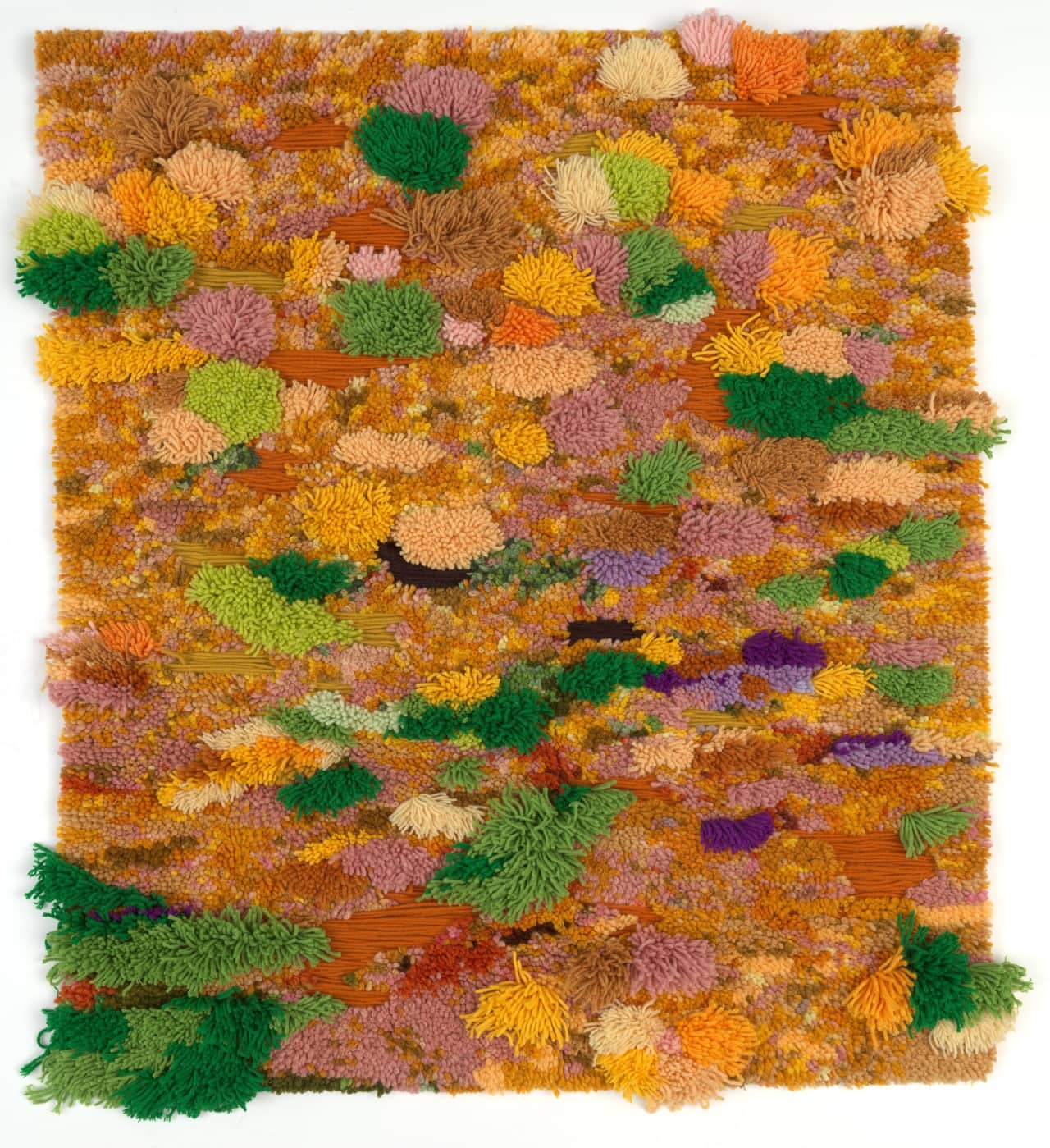
Sophie Honess Daruka – grass 2024
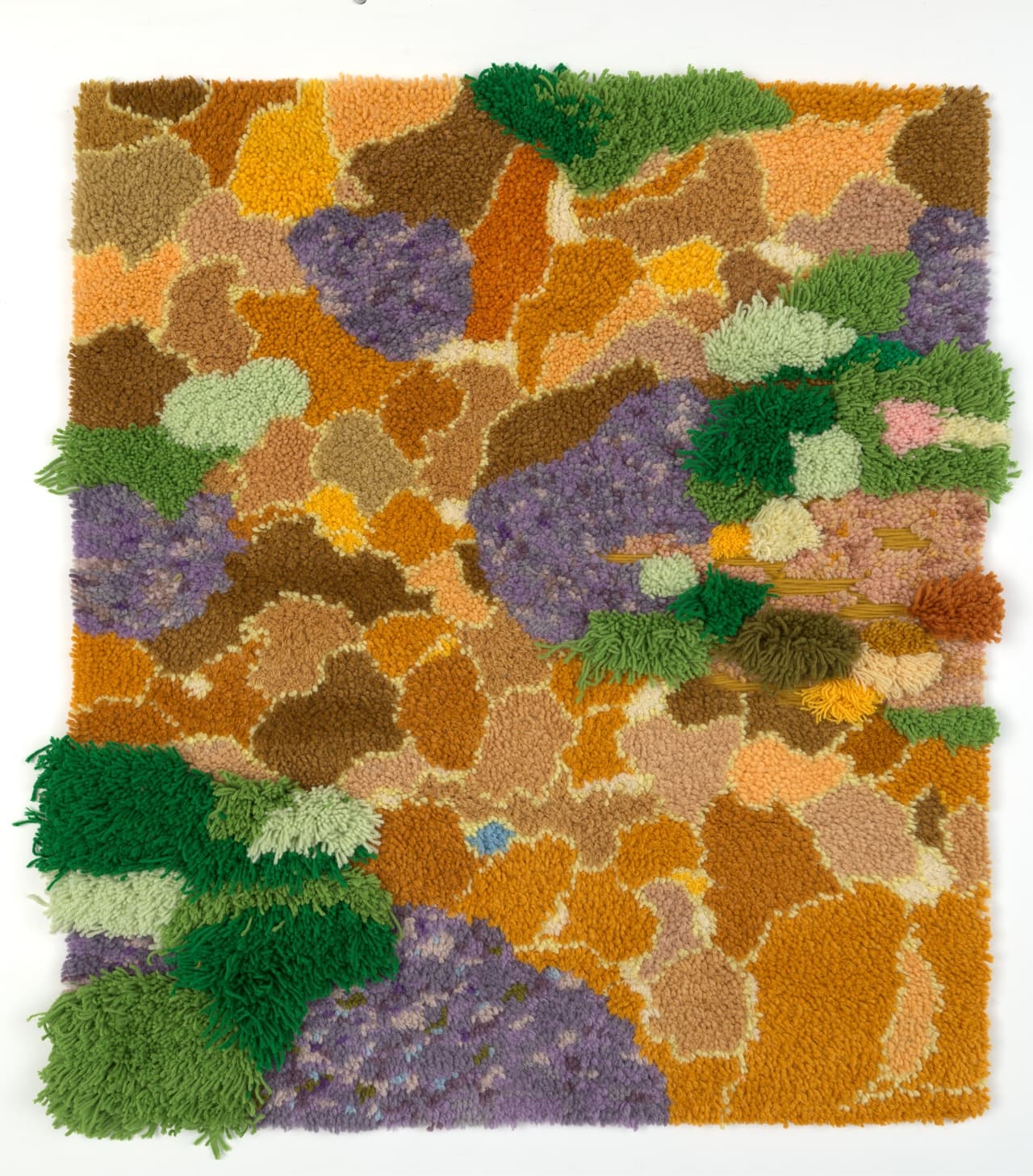
Sophie Honess Daruka – water 2024
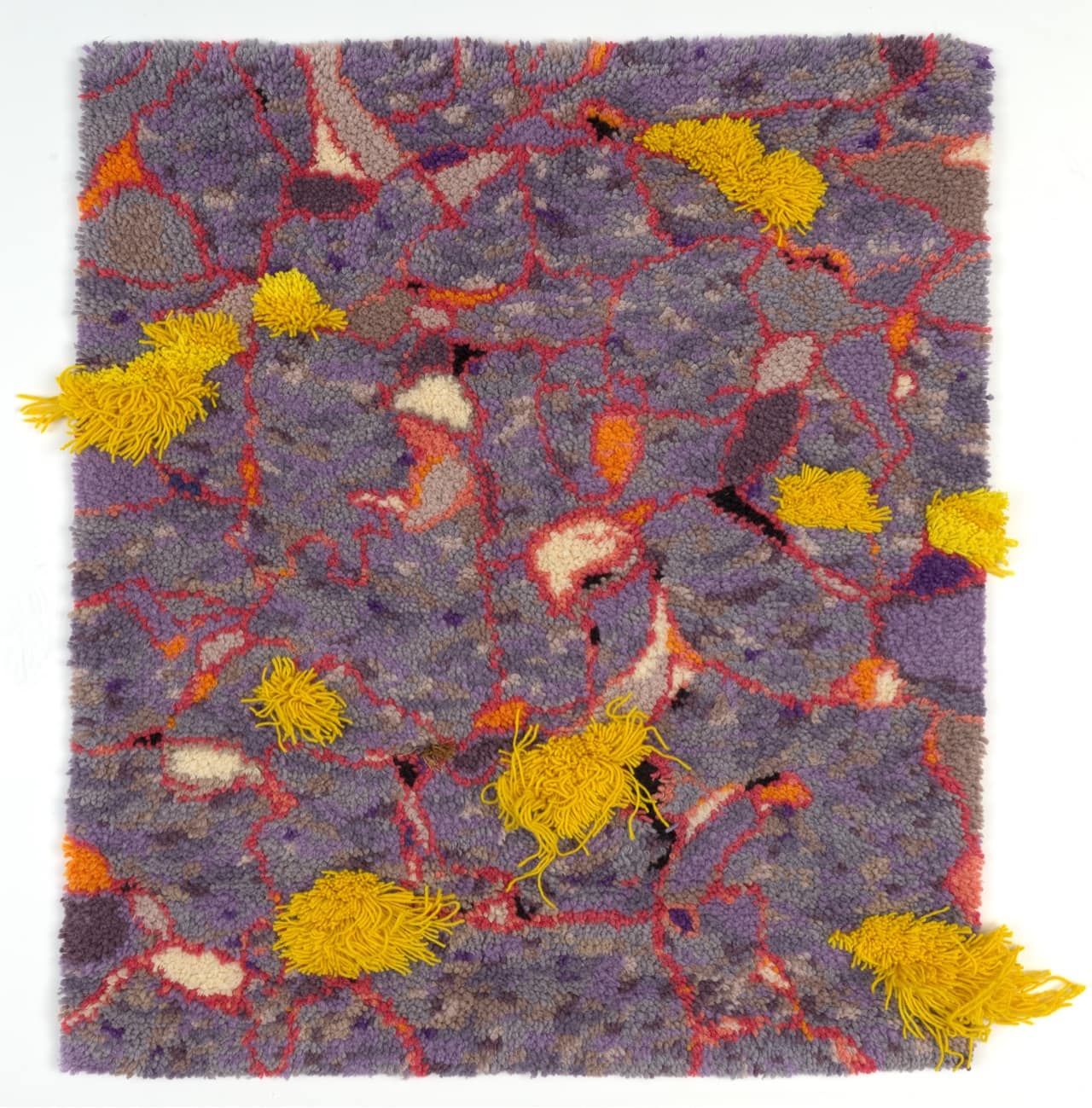
Sophie Honess Daruka – granite 2024
Cheryl Rose is committed to depicting fragments of cultural landscapes and translating their forms. For this commission, Rose was mentored by Denise Robinson. Both descendants of the Trawlwoolway people of lutruwita/Tasmania, Rose and Robinson have been working together on projects for more than fifteen years. Robinson saw this commission as a quintessential opportunity to bring Rose’s practice to the forefront of national discourse and, rather than direct Rose’s practice, Robinson sought to support her capacity as a ‘deep listener… to hear the pause when Cheryl spoke about Country and what it meant to her’. Through this process, Rose has realised Fragments, an installation centred on a large-scale work on Japanese Kozo paper. Gently collaged onto its surface are hand-rendered images and archival references to digging materials that were collected from the caves at pinmatik (Rocky Cape) and stored at the Tasmanian Museum and Art Gallery in the 1970s. Accompanied by an audiovisual component that provides the atmospheric sounds of this sacred site, the installation emanates the connectedness, emotion and healing Rose gets from her Country.
Also building upon a longstanding relationship but working for the first time towards a specific outcome, Girramay / Yidinji / Kuku Yalanji man Tony Albert selected Warraba Weatherall from the Kamilaroi Nation as his mentee. In his PhD research, Weatherall considers the relationship between oral and visual languages and responds to the complexities of colonialism and how it has become naturalised in contemporary society through systems of colonial bureaucracy and linguicide. Weatherall’s commission builds upon this research and permits time and resources to deeply consider archival materials and undertake new modes of fabrication. His work Dirge is a large-scale polyphon (a large disc-operated music box) that translates oppressive archival documents into braille to form a musical composition. Working with steel and monumental forms, Dirge explores notions of longevity, creation and destruction.
Already friends and professional supports to one another, Nunga (Kaurna Miyurna) and Māori (Te Arawa) man James Tylor identified that this mentorship and exhibition program would be a meaningful space for Aidan Hartshorn, a Walgalu man of the Ngurmal Nation, to develop his modes of making. For this commission, Hartshorn builds upon his master’s research, which considers the implications of the Snowy Mountains Scheme – Australia’s largest hydroelectricity and irrigation complex – which has and continues to be one of the major causes of decimation on his Country. Hartshorn has actively pursued working with new mediums, working with Canberra Glassworks to fabricate sixteen diamond-shaped glass shields to form an installation. Each shield is suspended in space and weighed down by electrical cords that illuminate them. This tension characterises what Hartshorn terms ‘ghost objects’ – the powerful yet burdened presence of these translucent shields speaking to the ways culture has been removed, obscured and misrepresented through colonial forces.
Peggy Griffiths identified the potential to share cultural and artistic practice through this commission program and thus chose to mentor her daughter, Jan Griffiths. Both are Miriwoong women from Kununurra in the East Kimberley, Western Australia. The native gerdewoon (boab tree) underpins the premise of Griffiths’s work Tree of knowledge. Gerdewoon is a source of nourishment – from the boab nuts to the water in its hollow trunk – as well as being central to birthing and to stories relating to Miriwoong being and knowing. Griffiths has utilised this supported commission to express the multiplicities of gerdewoon as personally and culturally sacred. Culminating as an installation that encompasses ceramics, painting and poetry, the experiential quality of the work presents a sacred story, holding knowledge passed down from her old people.
Bringing the lessons and ways of Tiwi culture to a global audience is central to the work of Johnathon World Peace Bush (Jon Jon). Jon Jon is mentored by his cousin Pedro Wonaeamirri and their shared ancestry and Country exist at the heart of this mentorship. Jon Jon has painted a triptych that brings together stories of when Jon Jon’s grandparents lived on Paluwiyanga Andranangoo Country (Goose Creek) with Western systems of laws. The subject and choice of materials and colours are vital expressions of Tiwi culture. He explains, ‘I make the work with ochres, from the ground, from the land’. Jon Jon and Wonaeamirri came together to produce a tunga (folded bark ceremonial basket), and a two-channel video work that offers insight into the strong culture of their practices. The video shows Jon Jon dancing his totem tartuwali (shark) with Pedro singing for Jon Jon on their shared Country.
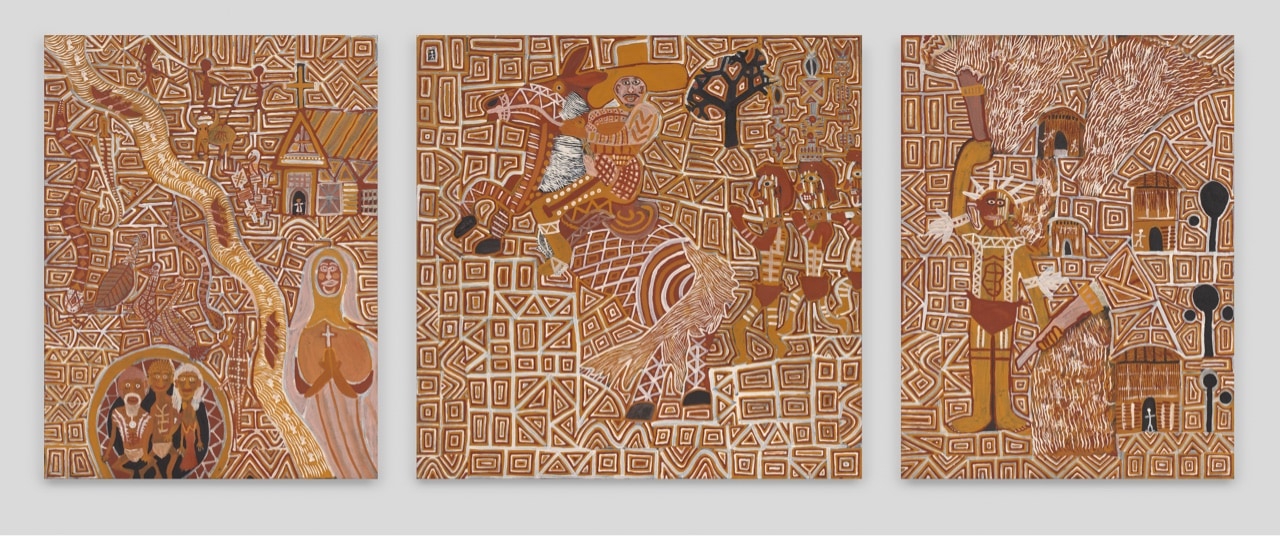
Installation view of Johnathon World Peace Bush Ngiya Murrakupupuni – the place back home, Murrintani on Appaloosa and Yikwani Kunganyi – fire and smoke 2024
The strength of story and the practice of cultural protocol is central to appreciating Alec Baker and Eric Barney’s two collaborative paintings titled Ngura (Country). Barney is a younger artist who paints in the proper way under the cultural mentorship of Baker, a senior lawman, and both are mentored by Vincent Namatjira OAM for this commission. This important way of working collaboratively is vital to the continuation of painting Tjukurrpa (ancestral dreaming). Namatjira comments that through the exhibition outcome, the artists are ‘bringing their Country to the big smoke’.
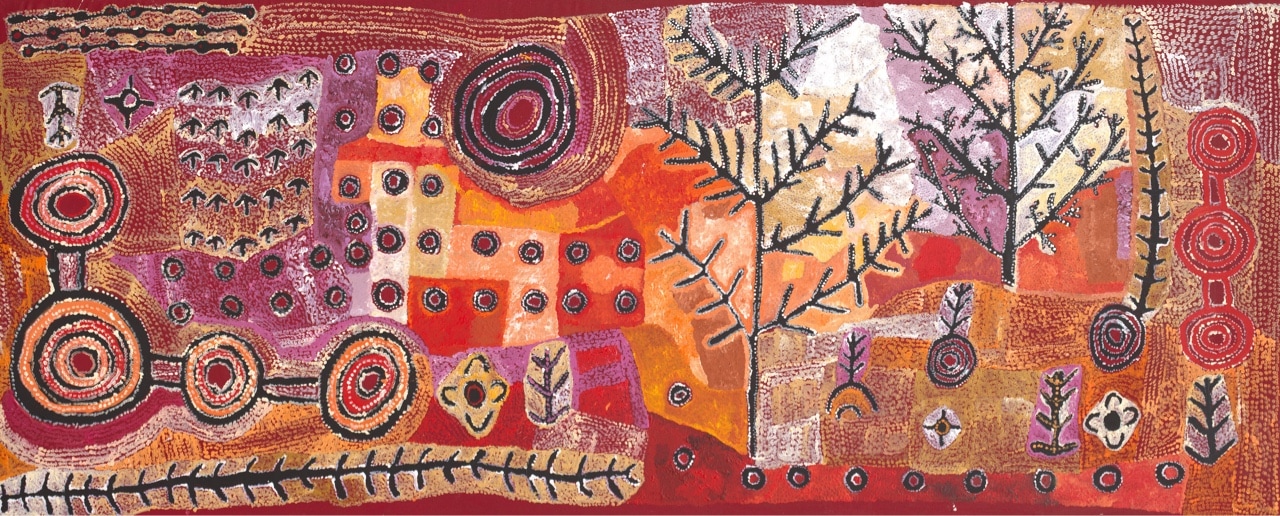
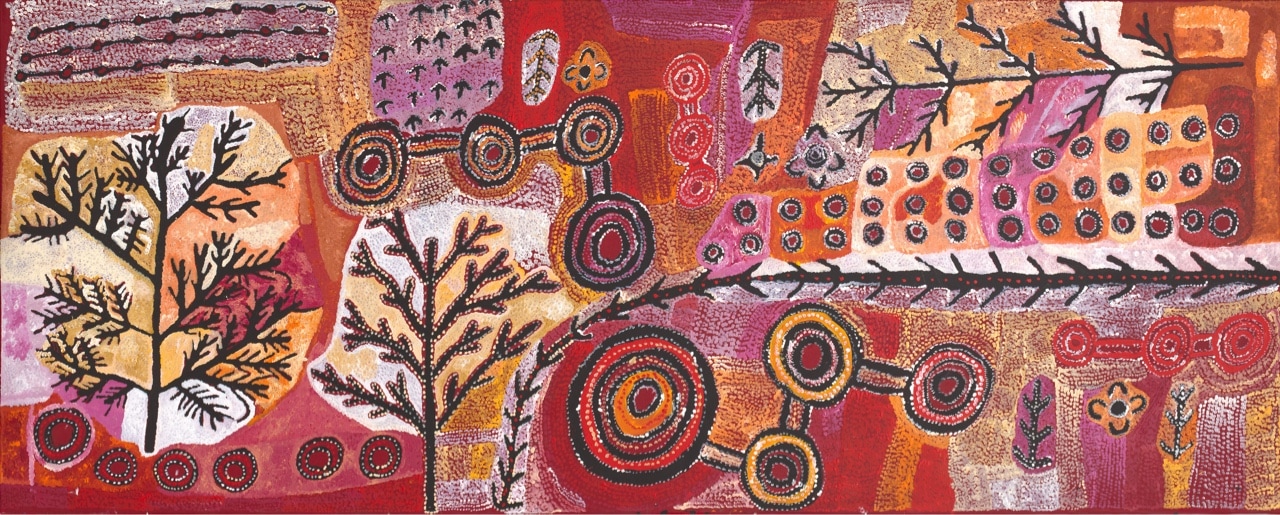
Alec Baker and Eric Barney Ngura (Country) 2024
Boonwurrung and Barkindji man Mitch Mahoney has been working alongside his aunt and mentor, Mutti Mutti, Yorta Yorta and Boonwurrung / Wemba Wemba woman Maree Clarke for the past five years. Clarke considered My Country as the right time for Mahoney to apply his strong skills to a major commission. Mahoney directed this opportunity towards Country, cultural revitalisation and working with materials to create two canoes, which represent his father’s Country, and a possum skin cloak, which honours his mother’s Boonwurrung culture, telling saltwater stories. Making a canoe is an extensive process and has many protocols. With further mentorship from Barkindji artist David Doyle, Mahoney undertook full and proper practice, from learning where to collect bark for a canoe to healing the tree with mud.
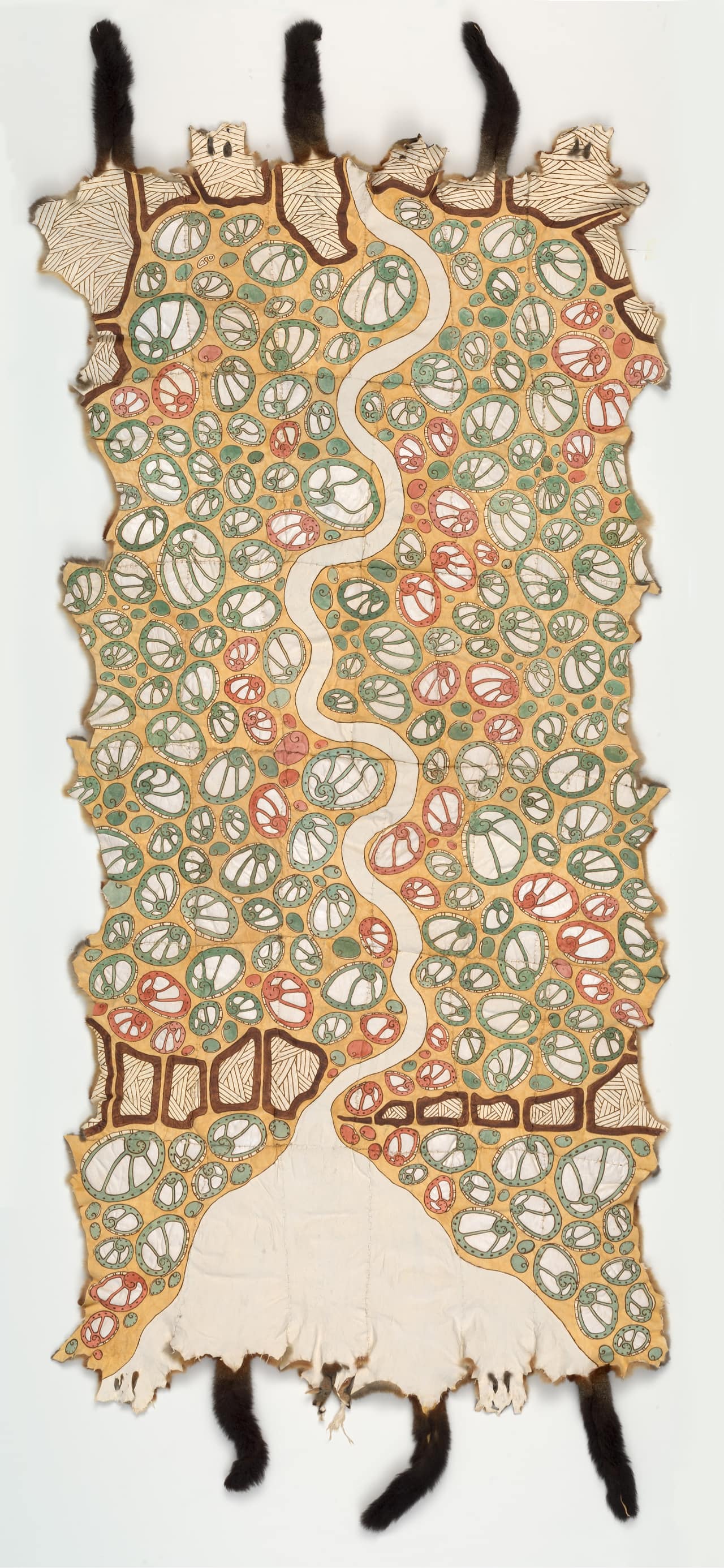
Mitch Mahoney Possum skin cloak (Mother) 2024
Reflecting upon the model of the Country Road + NGV First Nations Commissions, Jonathan Jones comments, ‘Supporting each other, in particular the next generation, is something that occurs naturally within the Aboriginal community. It’s part of being a community, we just don’t call it a mentorship’. Through acknowledging these systems within a formal and public context, My Country introduces audiences to the implications of colonisation, the importance of sustainable art-making, and to practices of caring for Country.
Edwina Green Curator, First Nations Art, NGV.
Sophie Prince Curatorial Project Officer, Australian and First Nations Art, NGV.